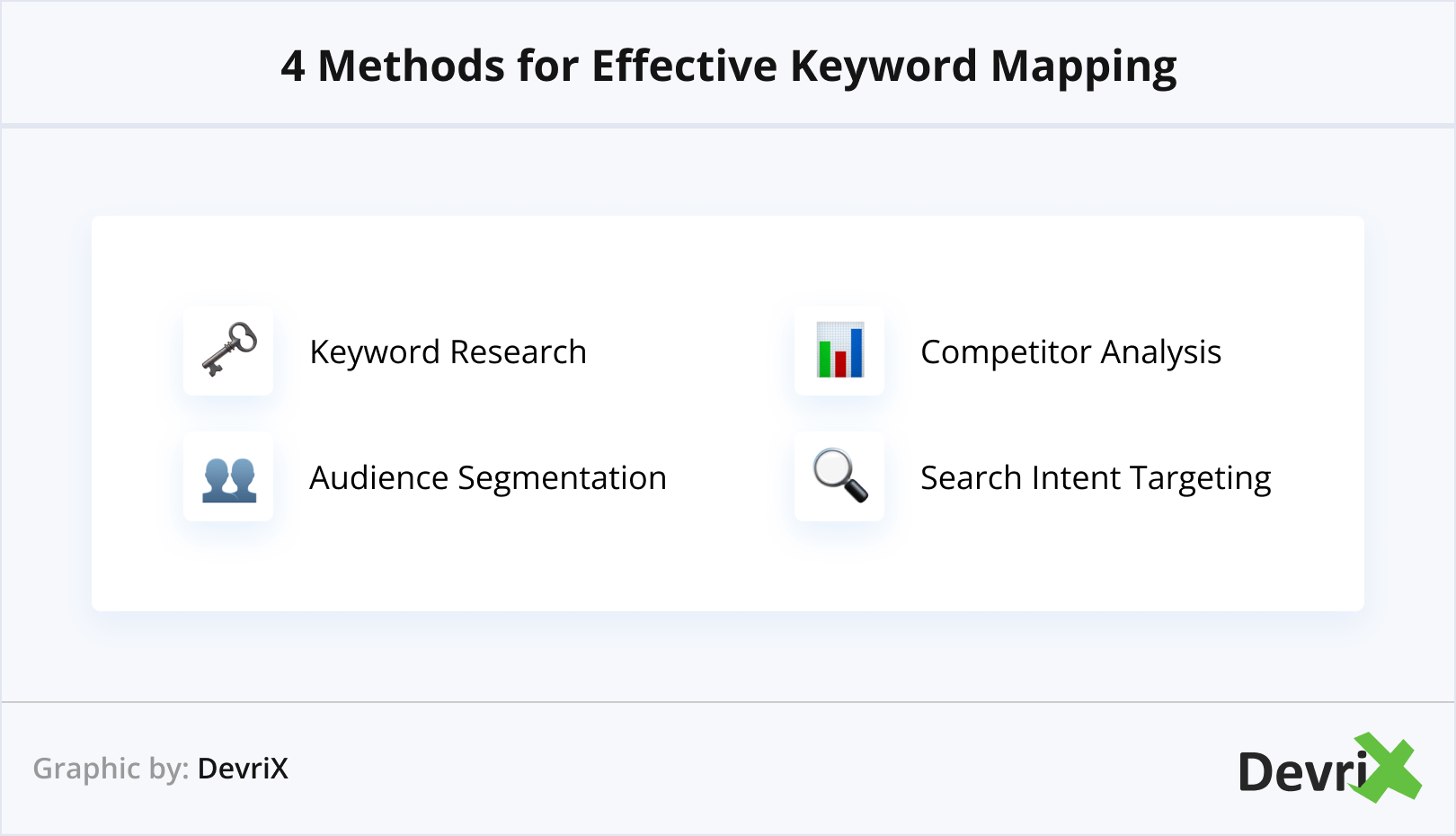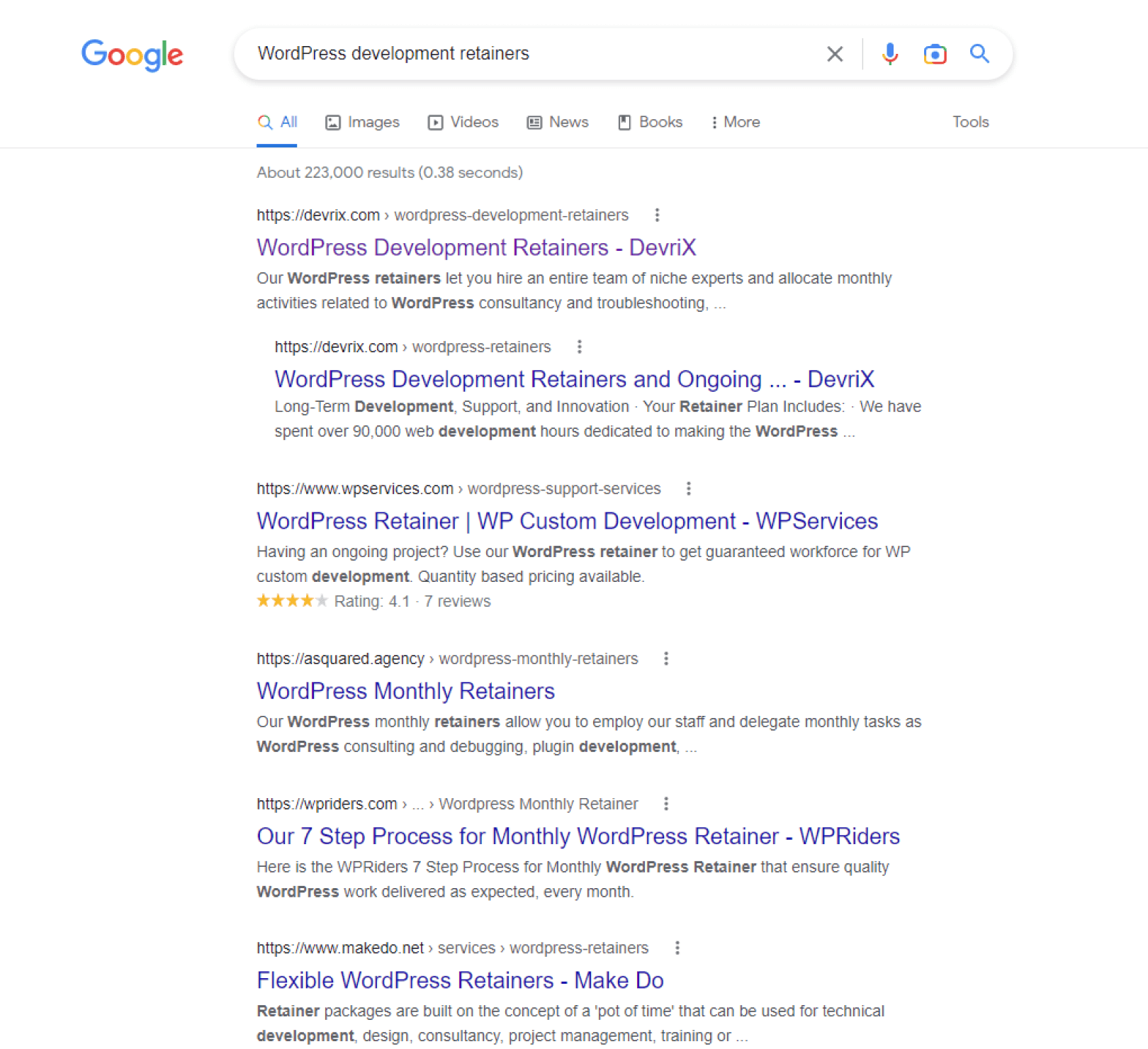Keyword mapping is the process of assigning a specific keyword for each of your web pages.This is essential if you want people to land on your site for specific search queries and use your services as opposed to your competitors.
Optimizing for the right keywords is quite straightforward at first sight. Based on the nature of your business, you can determine what search terms and phrases people would use to find you.
For example, DevriX is a WordPress web development company. Therefore, the keywords we aim to rank for are just that. For each of our services pages, we want to rank for search terms associated with the service at hand.
However, it is not that simple, and this is where good keyword research comes into play. Imagine if all the web development companies out there only ranked for their service keywords without making a difference! How do search engines decide how to position them in SERPs? Careful research of secondary and long-tail keywords, competitor analysis and keeping up with the latest SEO strategies is the way to go.
In this article, we will first define what keyword mapping is, the elements it consists of, and practical ways you can perform keyword mapping for your website.
What Is Keyword Mapping?
Keyword mapping is the series of processes planning the keywords a website and its pages would rank for. Pages and keywords are arranged in topic clusters made of one focus keyword, its variations and long-tail search phrases.
Search engines rank websites based on the URLs of their pages. So, it’s important to include the main keyword (the topic) of each page in the URL slug.
The groups of topic clusters you outline form the topical structure of your website, or the website architecture.
To ensure good browsing functionality of your website, create clusters that correspond to users’ mental models Also, bet on an easy-to-navigate web design.
So, without further ado, let’s now explore what good keyword planning entails:

The Importance of Keyword Research
Keyword research is a crucial step in the process of SEO keyword mapping. It helps to identify the specific terms and phrases that potential customers are using to search for products or services like yours. By understanding the language that your target audience is using, you can ensure that your website and other online content is optimized for those keywords. This way, it is more likely to rank well in search engine results and be found by potential customers.
Also, keyword research helps to identify potential gaps in your content. Plus, it allows you to spot areas where you may not be effectively reaching your target audience. For example, if you find that a significant number of people are searching for a specific product or service that you don’t currently offer, add it to your offerings.
Additionally, by identifying keywords that are relevant to your business but that you’re not targeting, you can identify opportunities to create new content. Alternatively, you can optimize existing articles to better attract potential customers.
Keep in mind that keyword mapping does not only mean checking what content your direct competitors work with and the keywords they’ve optimized it for. Surely, that’s important to sustain your level. However, you need to also identify the search terms they don’t rank for but are relevant to your readership.
So, look outside of the box. Indirect competitors and publishers that post compelling content that gets viable traffic can also help you find valuable topics to cover.
Let us get a few ideas for keywords to inspire future blog titles for the DevriX blog from the renowned for its content Hubspot. For this purpose, I will explore the keyword gap between https://devrix.com/ and https://www.hubspot.com/ using Semrush:

Once I hit “Compare”, I get a pie diagram showing the keyword percentage we have in common. I pressed “Missing” to find out the keywords Hubspot ranks for and we don’t, and sorted the results by increasing keyword difficulty:

Once I identify the keywords that have decent volume and relatively low difficulty, I can then go ahead and click on the URL that ranks for them on the competitor’s website. This way, I will get an idea of how they’ve structured their content, and think about ideas on that topic that add more value so it also ranks well.
Overall, keyword research is an essential part of keyword mapping. It can help you to gain a better understanding of your target audience, identify opportunities to improve your online presence, and increase your chances of ranking well in search engine results.
By taking the time to conduct a thorough keyword research, you can ensure that your website and other online content is optimized to reach your target audience and drive more traffic, leads, and sales.
Competitor Analysis
Performing a thorough competitor analysis regularly is fundamental to making sure you have the upper hand within your industry and improve it if necessary.
We already saw an example of monitoring the keyword gap with another website. However, how do you find out who your direct competitors are and what they do differently?
There are different ways to go about it.
Competitor Analysis Via Search Engines
For example, you can simply type in your main keyword(s) in Google, hit “Search” and go through each of the results on the first page. This may be the easiest way to identify SEO competitors, but not direct business competitors per se. Let’s do an example:
I entered the search query “WordPress development retainers”:

As you can see, we hold the top position in the SERPs for this query. However, it contains the word “retainers” which holds semantics of buying and looking for a service provider. Therefore, the other search results are direct competitors to DevriX.
However, let’s try with another main keyword for us – “WordPress plugin development”:

As you can see, the search results are mostly tutorials They are not pages competing with our service page https://devrix.com/wordpress/plugin-development/ (although it is optimized for “WordPress plugin development”). In fact, it appeared all the way to SERP 6.
However, we have other web pages on DevriX that we have optimised for this keyword:
https://www.google.com/search?q=site%3Ahttps%3A%2F%2Fdevrix.com+wordpress+plugin+development&oq=site%3Ahttps%3A%2F%2Fdevrix.com+wordpress+plugin+development&aqs=chrome..69i57j69i58.15373j0j4&sourceid=chrome&ie=UTF-8
They are still nowhere to be found in the first 10 SERPs. In this case, we need to look into these pages, and compare them with the top 10 ones – to get ideas of what we can tweak to rank well too. Updating with fresh information, visuals and secondary keywords may just do the trick.
So, a simple search on Google may work well for money keywords. However, it is not a reliable way to find direct competitors for analysis of other types of phrases.
Competitor Analysis Via SEO Tools
If you want to do a more in-depth competitor analysis, we’d recommend using one of the tools we’ve listed further down in the article.
For example, if you type in the keyword you are interested in exploring in the Semrush Keyword Overview Tool, you will get a bunch of useful insights that will point out the reason why search engines preferred a competitor to you. These include keyword volume, difficulty, (search) intent, trend, keyword variations, related keyword and questions (that would appear for this term in Google’s ‘People Also Ask’ feature). Also, you can see a SERP analysis of the pages that rank for that keyword along with their metrics (Authority Score, Referring Domains, Backlinks, Search Traffic, and URL Keywords).
Audience Segmentation
Using psychographic targeting to identify different segments of your audience is an effective keyword mapping method. By analysing the behaviours of your visitors, you can map out your keyword and content to resonate with separate, granular groups of your audience. And as we know, personalization is key in sustaining customer relationships and trust in your brand.
Audience segmentation is the process of breaking down a target market into smaller groups of consumers with similar needs or characteristics. Practical ways to segment your audience for better content marketing results include:

Demographic segmentation: Dividing your audience based on characteristics such as age, gender, income, and education level. This can help you tailor your content and better understand the motivations and needs of your target market.
Behavioural segmentation: Grouping consumers based on their behaviors, such as purchase history, web browsing habits, and brand loyalty. This type of segmentation can help you identify individuals most likely to engage with your content and convert into customers.
Psychographic segmentation: Segmenting your audience based on their lifestyle, personality, and values. This way, you can create content that resonates with specific segments of your audience, such as those who are environmentally conscious or health-conscious.
Geographic segmentation: Dividing your audience based on their location and tailoring your content to specific regions or cities.
By segmenting your audience, you can tailor your keywords to specific groups of consumers and drive better results.
Search Intent
Analyzing search intent is a crucial step in optimizing your content for specific in-demand keywords. It refers to the reason behind a user’s search query. It can be broken down into four main categories: navigational, informational, transactional, and commercial investigation.
To determine search intent, you can start by reviewing the keywords and phrases that users are interested in. Look for patterns and themes in the search queries to identify the intent behind them. For example, if a significant number of users are searching for “buy [product name],” it’s likely that their intent is transactional. On the other hand, if users are searching for “how to [do something],” their intent is likely informational.
Once you’ve identified the intent behind a user’s search query, you can optimize your content to match it. For example, if the intent is transactional, create guides on the purchasing process, including product features, pricing, and customer reviews. If the intent is informational, your content should focus on providing helpful, informative, and educational resources to users.
Additionally, you can use tools like Google Search Console, Ahrefs, and SEMrush to identify the keywords and phrases that drive the most traffic to your website. Also, you can use different methods such as Google scraping to gather more in-depth information on your competitors and create a stronger SEO strategy. Analyze the search queries that lead to your website and identify the intent behind them. Use this information to plan your keyword mapping strategy. Tis way you can then create new content that will satisfy your target audience.
8 Keyword Mapping Tools to Maximise Your SEO Gains
In order to analyse your SEO efforts and plan what keywords to go for, here are 8 tools to benefit from:
- Google Search Console: Google Search Console is the ultimate tool for managing the keywords of your website. You should refer to it often and make adjustments on a regular basis.
- Google Analytics: Google Analytics is great for tracking users’ behaviour on your website. You can integrate your GSC into GA to monitor how your audience reacts to any tweaks in your ranking keywords.
- Google Trends: Google Trends allows users to view the popularity of specific search terms over time. You can use it to identify trending topics and compare the popularity of different keywords. This way, you gain insights into the interests and behavior of online users.
- Semrush: Semrush provides valuable insights on a website’s organic search, paid search, backlinks, keywords, and competitor analysis. It helps users to optimize their online visibility and improve their search engine rankings.
- Ahrefs: Similar to Semrush, but best for backlinks analysis.
- Ubersuggest: A free SEO tool to find keywords, generate content ideas, and analyze the performance of your website and competitors. It provides insights and suggestions for improvement and is best for long-tail keywords.
- AnswerThePublic: Like Ubersuggest, this tool is owned by Neil Patel. It helps users to identify questions and topics that their audience most frequently search for.
- Rank Tracker: A good alternative of GSC and GA combined.
Final Thoughts
And there you have it! We’ve outlined what the main keyword mapping elements are. Also, we’ve shared a few tips on how to plan your SEO efforts effectively. Make sure to use different tools to compare results and get a better picture on what you need to improve.
Keep in mind that DevriX offers WordPress SEO services that can skyrocket your online presence.




